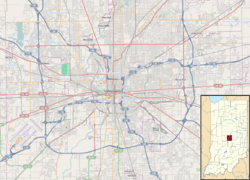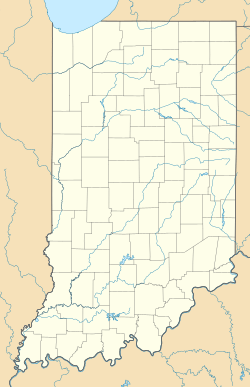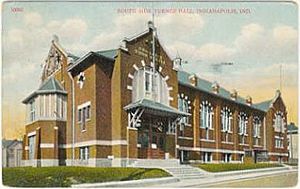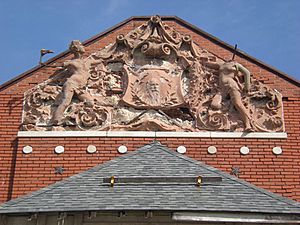South Side Turnverein Hall facts for kids
Quick facts for kids |
|
|
South Side Turnverein Hall
|
|
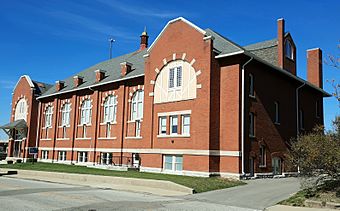
South Side Turnverein Hall, 2020
|
|
| Location | 306 Prospect St., Indianapolis, Indiana |
|---|---|
| Area | 0.64 acres (0.26 ha) |
| Built | 1900 |
| Architect | Vonnegut & Bohn |
| Architectural style | Renaissance Revival |
| NRHP reference No. | 100004724 |
| Added to NRHP | December 3, 2019 |
The South Side Turnverein Hall is a historic building in Indianapolis, Indiana. It was once a social club and gym for the city's German-American community. Famous architects Vonnegut & Bohn built it in 1900. These architects, Bernard Vonnegut, Sr. and Arthur Bohn, were part of the growing German-American community in Indianapolis. They also designed the Athenæum, another German-American club in the city.
The South Side Turnverein Hall was a key meeting place for the German community on the south side of Indianapolis. It was very active until the 1940s. In 1978, it was sold to new owners who used it as a sports club. This important building was added to the National Register of Historic Places in 2019.
Contents
History of the Turnverein Hall
In the 1800s, many German immigrants came to Indianapolis. They came after political problems in Europe, especially after the failed Revolutions of 1848. By 1850, over 12% of the city's people were of German heritage. This growing German community wanted to keep their traditions alive. They did this by creating social clubs.
The Turner movement was a large German-American cultural group at that time. It promoted German ideas through education and physical fitness. The Turner movement created Turnvereins, which were like gymnastics clubs. Members met there for social events and sports. The Turner movement came to Indianapolis in the 1850s with the Socialer Turnverein club.
By 1893, more German people lived on the south side of the city. They wanted their own Turnverein. About 200 German-Americans left the Socialer Turnverein to start the South Side Turnverein (Südseite Turnverein).
The group first rented a space. But as more people joined, they looked for a permanent home. They chose a spot near Madison Avenue and Prospect Street. Building started in June 1900 and finished in November of that year. When it first opened, the South Side Turnverein Hall offered eight gymnastics classes. About 300 students, aged 6 to 25, attended these classes. The building had two bowling alleys, a dining room, a kitchen, a bar, and a large gym. The gym could also be an auditorium for over 800 people.
Sports and Activities at the Hall
The South Side Turnverein focused on physical education. It hosted many sports events over the years. These included gymnastics shows, basketball games, bowling leagues, and boxing matches. Every April, the hall held an annual exhibition. This event featured gymnastics, folk dances, and music from orchestras. It also hosted many regional Turner events. These events brought up to 500 athletes and large crowds from cities like Chicago, Louisville, Fort Wayne, and Evansville.
The Turnverein had its own basketball team. They played against teams from the Christamore House, Crawfordsville High School, and other local groups. The hall hosted several basketball leagues. Reports say it held more than 18,000 refereed basketball games between 1904 and 2014.
Social Gatherings and Community Events
From when it was built until the late 1930s, the South Side Turnverein was a key part of the German community. It also served the wider south side area. It hosted musical performances, dances, plays, festivals, and other events. Some events celebrated German heritage. Others were for the city or other social clubs. Local groups like the Knights of Pythias and the Young Men's Institute held events at the Turnverein.
The building also hosted many labor union and political events. Local labor unions, such as the United German Trade Unions of Indianapolis, used the building. It was also a place for labor groups to meet and discuss agreements in the 1940s and 1950s.
A political rally for the Progressive Party took place at the Turnverein in 1912. The building even hosted a campaign visit by John F. Kennedy during his 1960 presidential campaign.
Changes and Decline
During World War I and World War II, people in the United States sometimes felt negative towards German-Americans. German-American groups had to adapt. In 1918, the South Side Turnverein held a meeting for "persons of German blood." At this meeting, they passed statements supporting the United States in its war against Kaiser Wilhelm II of Germany. Around this time, the building's name was changed to sound more English. It was often called the South Side Turner Hall or South Side Turners' Gymnasium.
In the late 1930s, the South Side Turnverein had about 400 members. By 1977, this number had fallen to just 62 members. The neighborhood around the building had changed. Many former members moved to the suburbs of Indianapolis. The building of Interstate 70 right north of the building in the 1970s also contributed to the club's decline. In December 1978, the Turnverein building was sold to investors. The club's activities moved to a new location.
After being sold, the building was used as a sports club, a bar, and a music venue at different times. Most recently, it was changed into office space.
Building Design
The South Side Turnverein Hall is a two-story building. It is built in the German Renaissance Revival style. It has a raised basement and sits on a strong limestone foundation. The outside is made of red brick with limestone decorations. It has a sloped roof with decorative sections called gabled pavilions. There are brick columns on its south side that go up through the roof. A small, eight-sided tower called a cupola sits on top of the roof.
A special part of the building is its arched windows and panels on the north and south sides. In the middle, there are five sets of single windows on the first floor. Above them, on the second floor, are three-part arched windows. The arches have unique limestone voussoirs (wedge-shaped stones) and springers (the stones where the arch begins). The decorative pavilions also have similar arched panels on their north and south sides. These panels have a half-timber and stucco design with two large windows in the center. They share the same arched shape as the windows in the main part of the building.
On the west-facing side, there is a relief (a sculpture that sticks out from a flat surface) of Friedrich Ludwig Jahn. He is known as the father of the Turner Movement. This sculpture was made by the famous artist Rudolf Schwarz. Schwarz also created art for the Soldiers' and Sailors' Monument in downtown Indianapolis. The original sculpture on the Turnverein Hall was badly damaged over time. It was replaced with a new one during renovations in 2019. Parts of the original sculpture are now displayed inside the building.


